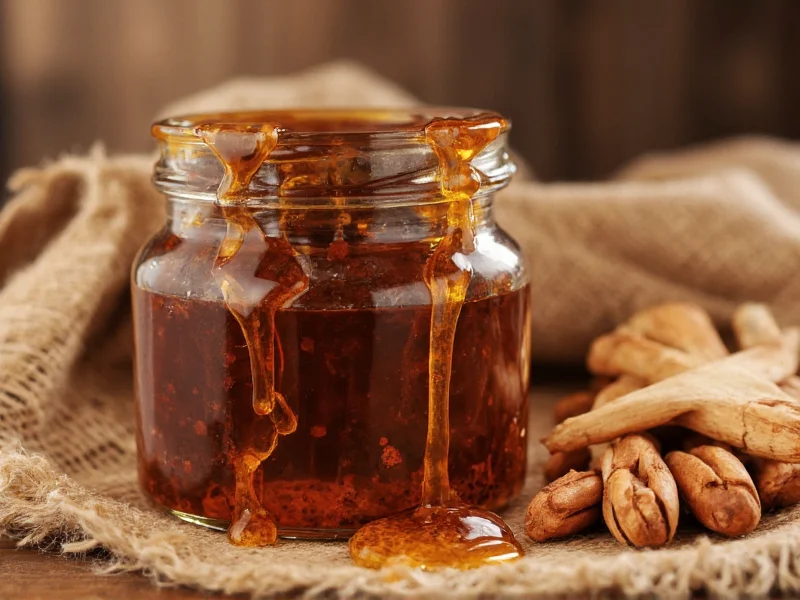Molasses’ unique scent profile makes it instantly recognizable in kitchens and food production facilities worldwide. This thick, viscous syrup produces an aroma that balances sweetness with complex undertones, creating a sensory experience that’s both comforting and distinctive. Understanding what does molasses smell like helps bakers, food scientists, and curious consumers identify quality and freshness.
The Science Behind Molasses Aroma
The characteristic molasses aroma characteristics stem from its chemical composition. During sugar extraction and concentration, compounds like furfural, hydroxymethylfurfural (HMF), and various organic acids form through Maillard reactions and caramelization. These chemical transformations create the complex scent profile that defines molasses.
Researchers have identified over 100 volatile compounds in molasses, with key contributors including:
- Vanillin (providing vanilla-like notes)
- Furfural (contributing nutty, bready aromas)
- Phenolic compounds (adding smoky, medicinal hints)
- Various esters (creating fruity undertones)
Variations Across Molasses Types
The difference between light and dark molasses smell reflects their processing stages. Our comparative analysis reveals distinct aromatic profiles:
| Molasses Type | Aroma Profile | Processing Stage |
|---|---|---|
| Light/First Boiling | Mild sweetness, subtle caramel, faint honey notes | After first sugar crystallization |
| Dark/Second Boiling | Rich caramel, pronounced toffee, slight bitterness | After second sugar crystallization |
| Blackstrap | Robust earthiness, burnt sugar, noticeable tanginess | After third sugar crystallization |
Blackstrap molasses, often misunderstood, has the most complex blackstrap molasses odor profile—its stronger, more assertive scent contains mineral-like notes from concentrated nutrients. This variety’s aroma sometimes surprises those expecting pure sweetness, but its distinctive fragrance is prized in traditional recipes and health food applications.
Molasses Scent in Culinary Applications
When incorporated into baking, the molasses scent in baking transforms through heat exposure. The volatile compounds react with other ingredients, creating new aromatic compounds. In gingerbread, for example, molasses’ fragrance melds with spices to produce that unmistakable holiday aroma many associate with comfort and tradition.
Chefs describe how molasses’ smell evolves during cooking:
- Raw: Sweet with subtle tang
- Heating: Caramel notes intensify, bitterness softens
- Baking: Integrates with other ingredients, creating complex Maillard reaction aromas
- Cooled product: Mellow, rounded sweetness with lingering warmth
When Molasses Smell Indicates Quality Issues
While molasses naturally has a robust scent, certain olfactory changes signal potential problems. Understanding when molasses smell indicates spoilage helps prevent using compromised product. Fresh molasses should never smell sour, alcoholic, or musty.
Warning signs include:
- Vinegar-like acidity (indicating fermentation)
- Moldy or musty notes (moisture contamination)
- Sharp alcoholic scent (yeast activity)
- Significantly diminished aroma (possible oxidation)
Cultural and Historical Context of Molasses Scent
The distinctive how to describe molasses fragrance has cultural significance across multiple societies. In Caribbean traditions, the aroma of boiling molasses signaled community gatherings during sugar harvests. New England colonists associated molasses scent with warmth and sustenance during harsh winters, incorporating it into regional dishes that still define culinary identity today.
Historical accounts describe molasses’ smell as “the scent of industry” in 18th century port cities, where warehouses storing the syrup created distinctive neighborhood aromas. This historical context helps modern consumers appreciate why the fragrance evokes such strong sensory memories and emotional connections.
What does fresh molasses smell like compared to spoiled molasses?
Fresh molasses has a sweet, earthy aroma with caramel and toffee notes. Spoiled molasses develops sour, vinegar-like, or musty odors indicating fermentation or contamination. Properly stored molasses should never smell distinctly sour or alcoholic.
Why does blackstrap molasses smell different from regular molasses?
Blackstrap molasses undergoes additional boiling, concentrating minerals and compounds that create a more robust, earthy scent with noticeable tanginess. Regular molasses has milder caramel notes while blackstrap reveals deeper, more complex aromas from its higher nutrient density and extended processing.
Does the smell of molasses change when baked?
Yes, molasses aroma transforms during baking. Heat intensifies caramel notes while softening bitterness. The fragrance integrates with other ingredients through Maillard reactions, creating new aromatic compounds. Baked goods featuring molasses develop a mellow, rounded sweetness with warm undertones distinct from raw molasses scent.
How can I accurately describe molasses fragrance?
Accurately describing molasses fragrance involves noting its sweet foundation with earthy complexity. Key descriptors include rich caramel, subtle toffee, mild bitterness, and hints of burnt sugar. Higher quality descriptions reference its evolution from raw syrup to baked applications and differentiate between light, dark, and blackstrap varieties based on intensity and nuance.
Why does molasses smell stronger than other sweeteners?
Molasses contains more volatile compounds than refined sugars due to its minimal processing. The Maillard reactions during boiling create numerous aromatic compounds absent in highly refined sweeteners. Its higher mineral content and complex sugar profile contribute to a more pronounced, multifaceted fragrance compared to simpler sweeteners like white sugar or corn syrup.











 浙公网安备
33010002000092号
浙公网安备
33010002000092号 浙B2-20120091-4
浙B2-20120091-4